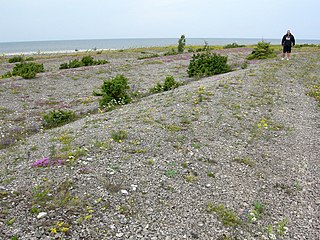Related Research Articles

A beach ridge is a wave-swept or wave-deposited ridge running parallel to a shoreline. It is commonly composed of sand as well as sediment worked from underlying beach material. The movement of sediment by wave action is called littoral transport. Movement of material parallel to the shoreline is called longshore transport. Movement perpendicular to the shore is called on-offshore transport. A beach ridge may be capped by, or associated with, sand dunes. The height of a beach ridge is affected by wave size and energy.

Rhodotorula is a genus of pigmented yeasts, part of the division Basidiomycota. It is readily identifiable by distinctive orange/red colonies when grown on Sabouraud's dextrose agar (SDA). This distinctive color is the result of pigments that the yeast creates to block out certain wavelengths of light (620–750 nm) that would otherwise be damaging to the cell.
H. rubra may refer to:

Maduramicin (maduramycin) is an antiprotozoal agent used in veterinary medicine to prevent coccidiosis. It is a natural chemical compound first isolated from the actinomycete Actinomadura rubra.

The diarylheptanoids are a relatively small class of plant secondary metabolites. Diarylheptanoids consist of two aromatic rings joined by a seven carbons chain (heptane) and having various substituents. They can be classified into linear (curcuminoids) and cyclic diarylheptanoids. The best known member is curcumin, which is isolated from turmeric and is known as food coloring E100. Some other Curcuma species, such as Curcuma comosa also produce diarylheptanoids.

Myricanone is a cyclic diarylheptanoid isolated from the bark of Myrica rubra (Myricaceae).
Aurivirus is a genus of viruses in the order Herpesvirales, and one of only two genera the family Malacoherpesviridae. Haliotid molluscs serve as natural hosts. There is only one species described in this genus, Haliotid herpesvirus 1 (AbHV-1), commonly known as abalone herpesvirus. A disease associated with this virus is acute ganglioneuritis.
Sphingomonas rubra is a Gram-negative, rod-shaped, neutrophilic and motile bacteria from the genus of Sphingomonas which has been isolated from wastewater from a leather plant in China.
Acer whitebirdense is an extinct maple species in the family Sapindaceae described from a number of fossil leaves and samaras. The species is known from Miocene sediments exposed in Idaho, Oregon and Washington in the United States. It is one of several extinct species belonging to the living section Rubra.
Acer taggarti is an extinct maple species in the family Sapindaceae described from a number of fossil leaves and samaras. The species is known from Miocene sediments exposed in central Oregon, US. It is one of several extinct species belonging to the living section Rubra.
Roseomonas is a genus of Gram negative bacteria. The cells are coccoid rods when viewed microscopically. Certain species are known to be opportunistic infections for humans.
Roseomonas rubra is a species of Gram negative, strictly aerobic, coccobacilli-shaped, red-colored bacterium. It was first isolated from lagoon sediments located near North Carolina State University in 2015, and the species was first proposed in 2016. The species name comes from Latin rubra (red), referring to the color that the bacterial colonies form.
Roseomonas sediminicola is a species of Gram negative, strictly aerobic, coccobacilli-shaped, pale red-colored bacterium. It was first isolated from sediment from a freshwater duck lake at the university KAIST in Daejeon, South Korea, and the species was first proposed in 2014. The species name is derived from Latin sedimen (sediment) and cola.
Roseomonas suffusca is a species of Gram negative, strictly aerobic, coccobacilli-shaped, light brown-colored bacterium. It was first isolated from lagoon sediments located near North Carolina State University in 2015, and the species was first proposed in 2017. The species name comes from Latin suffusca (brownish), referring to the color that the bacterial colonies form, as opposed to the pink coloration of most members of the genus Roseomonas.
Malonomonas is a Gram-negative, non-spore-forming, chemoorganotrophic, anaerobic and motile genus of bacteria with single polar flagellum from the family of Pelobacteraceae with one known species . Strains of Malonomonas have been isolated from anoxic sediments. the bacteria Malonomonas rubra bacteria metabolizes malonate.
Aquimarina rubra is a Gram-negative, rod-shaped and non-motile bacterium from the genus of Aquimarina which has been isolated from sediments from a pond which was cultivated with sea cucumbers from Rongcheng in China.
Terrimonas rubra is a Gram-negative, rod-shaped, non-spore-forming and non-motile bacterium from the genus of Terrimonas which has been isolated from polluted farmland soil from China.
Hyunsoonleella is a genus of bacteria from the family of Flavobacteriaceae.
Hyunsoonleella aquatilis is a bacterium from the genus of Hyunsoonleella which has been isolated from water from the Jeongbang Waterfall.
Hyunsoonleella jejuensis is a Gram-negative, aerobic, rod-shaped and non-motile bacterium from the genus of Hyunsoonleella which has been isolated from seawater from the coast of the Jeju Island.
References
- 1 2 "Species: Hyunsoonleella rubra". lpsn.dsmz.de.
- 1 2 Shi, Ming-Jing; Xie, Zhi-Hong; Zhang, Hui; Du, Zong-Jun (1 February 2017). "Hyunsoonleella rubra sp. nov., isolated from coastal sediment". International Journal of Systematic and Evolutionary Microbiology. 67 (2): 386–390. doi: 10.1099/ijsem.0.001638 .
- 1 2 "Hyunsoonleella rubra". www.uniprot.org.